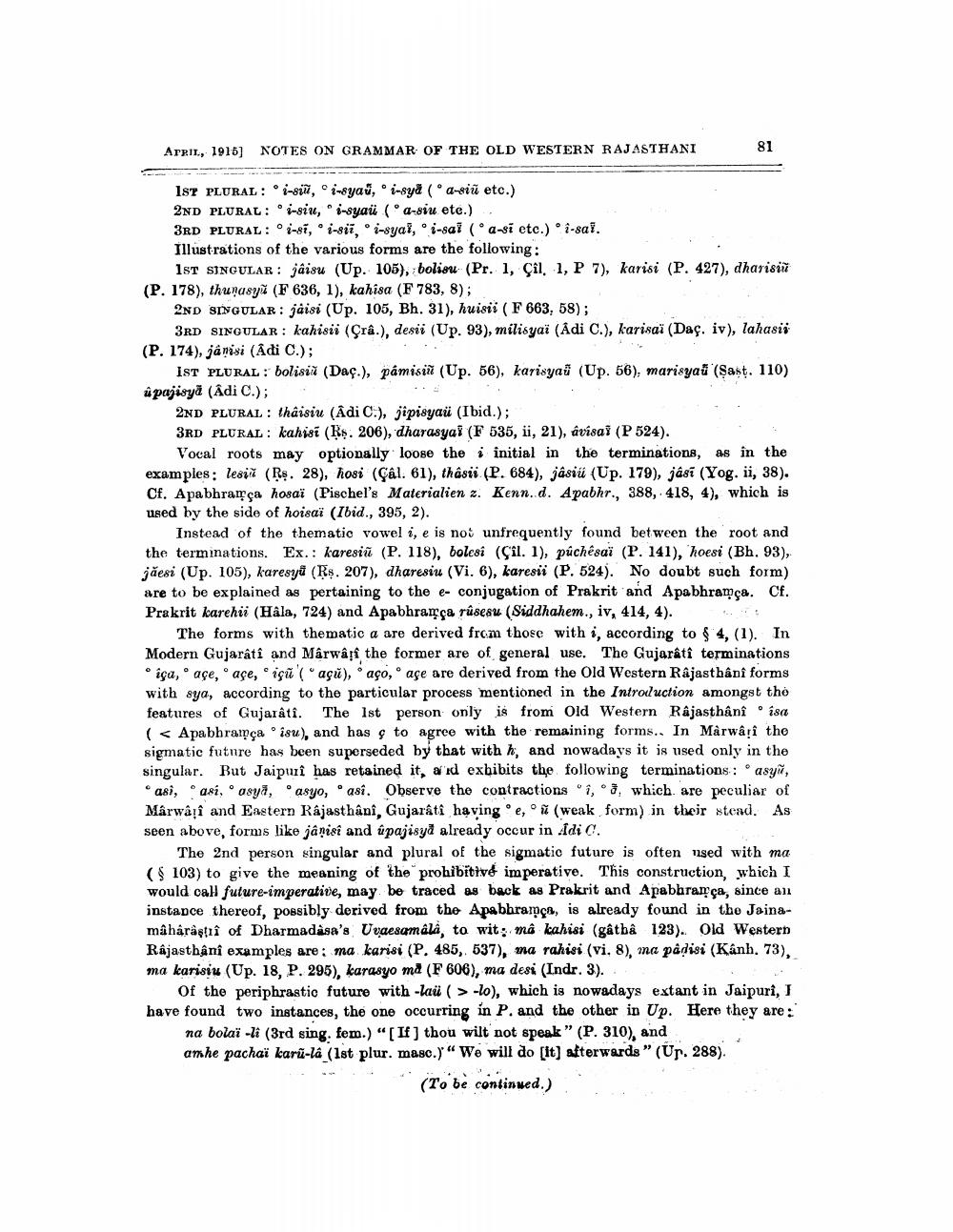________________
ATRII, 1916) NOTES ON GRAMMAR OF THE OLD WESTERN RAJASTHANI
81
1ST PLURAL: 1-8iū, i-syau, i-sya (a-siū etc.) 2ND PLURAL: ° i-siu, s-syaü (a-siu etc.). 3RD PLURAL: ° -81, -si7, i-syai, o i-sal (a-si etc.) o i-sai. Illustrations of the various forms are the following:
1ST SINGULAR: jaisu (Up. 105), boliou (Pr. 1, Çil. 1, P 7), karisi (P. 427), dharisiū (P. 178), thunusyu (F 636, 1), kahisa (F 783, 8);
2ND SINGULAR : jaisi (Up. 105, Bh. 31), huisii (F 663, 58);
3RD SINGULAR: kahisii (Fra.), desii (Up. 93), milisyai (Adi C.), karisaï (Dac. iv), lahasis (P. 174), janisi (Adi C.);
Ist PLURAL: bolisi (Daç.), pamist (Up. 56), karisyaü (Up. 56), marisyaü (şast. 110) û pajisyă (Adi C.);
2ND PLURAL: thaisiu (Adi C.), jipisyaü (Ibid.); 3RD PLURAL: kahisi (Rs. 206), dharasyal (F 535, ii, 21), ávisai (P 524).
Vocal roots may optionally loose the initial in the terminations, as in the examples: lesii (Rs. 28), hosi (Çâl. 61), thâsii (P. 684), jâsiű (Up. 179), jásī (Yog. ii, 38). Cf. Apabhramça hosaï (Pischel's Materialien z. Kenn. d. Apabhr., 388, 418, 4), which is used by the side of hoisaï (Ibid., 395, 2).
Instead of the thematic vowel i, e is not unfrequently found between the root and the terminations. Ex.: karesiū (P. 118), bolesi (Çil. 1), púchêsar (P. 141). "hoesi (Bh. 93), jaesi (Up. 105), karesya (Rs. 207), dharesiu (Vi. 6), karesii (P. 524). No doubt such form) are to be explained as pertaining to the e- conjugation of Prakrit and Apabhramca. Cf. Prakrit karehii (Hala, 724) and Apabhrarca rûsesu (Siddhahem., iv, 414, 4).
The forms with thematic a are derived from those with i, according to $ 4, (1). In Modern Gujarati and Marwari the former are of general use. The Gujarati terminations
iga, age, ace, igallagü), aco, age are derived from the Old Western Rajasthani forms with sya, according to the particular process mentioned in the Introduction amongst tho features of Gujarati. The 1st person only is from Old Western Rajasthani isa ( < Apabhrapça isu), and has g to agree with the remaining forms. In Marwari the sigmatic future has been superseded by that with h, and nowadays it is used only in the singular. But Jaipui has retained it, and exbibits the following terminations : asyi,
asi, asi, asya, asyo, asi. Observe the contractions i, o, which are peculiar of Marwâți and Eastern Rajasthani, Gujarati having e, o (weak form) in their stead. As seen above, forms like janisi and úpajisyd already occur in Aldi C.
The 2nd person singular and plural of the sigmatic future is often nsed with ma ($ 103) to give the meaning of the prohibitive imperative. This construction, which I would call future-imperative, may be traced as back as Prakrit and Apabhraça, since an instance thereof, possibly derived from the Apabhrapça, is already found in the Jainamaharastî of Dharmadása's Uvaesamála, to wit: ma kahisi (gâtbê 123). Old Western Rajasthani examples are: ma karisi (P. 485, 537), ma rahisi (vi. 8), ma pâdisi (Kanh. 73). ma karisiu (Up. 18, P. 295), karasyo md (F 606), ma desi (Indr. 3).
Of the periphrastic future with -laü ( > -lo), which is nowadays extant in Jaipuri, have found two instances, the one occurring in P. and the other in Up. Here they are:
na bolaï - li (3rd sing. fem.)“[If thou wilt not speak" (P. 310), and anhe pachai karû-là (1st plur. masc.)" We will do (lt) afterwards" (Ur. 288).
(To be continued.)




